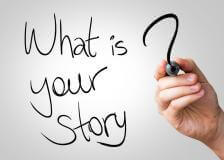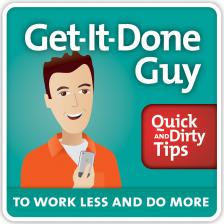How to Be Memorable (Part 1): Storytelling Tricks
Storytelling is the foundation for effective, memorable communication. Do it properly to hook your reader, draw them in, and keep their attention through the end. Get-It-Done Guy explains how.

“I really enjoy the little humorous side stories you create to enforce your topics. These make your podcasts special and easy to listen to. How do you do it? Is it just genius?”
Well Andreas, I’m so modest that I would never claim it’s genius. Or at least, it isn’t just genius. Once upon a time, Harvard Business School hired me to help redesign their curriculum. Step one: learn how humans learn. I spent a year reading everything the human race knows on learning theory. Stories figure prominently! So step behind the curtain and join me for a storytelling journey.
Sponsor: This episode is brought to you by lynda.com. Learn what you want, when you want, with access to over 2,700 high-quality online courses–all for one low monthly price. To try it free for 7 days, visit lynda.com/getitdone
Humans Remember Stories
According to the book Making Connections by Geoffrey and Renate Caine, humans have two separate memory systems. The one we usually think of is the taxon memory system, which is the one that remembers words, ideas, abstractions, facts, and figures. It’s the one that keeps forgetting your boyfriend, girlfriend, spousal equivalent, or polyamorous family unit’s birthday. Taxon memory requires study, repetition, and effort to use.
Memory system two is the locale memory system. It’s always on. What did you have for dinner last night? Where? You can remember these things easily, with no rehearsal. Your locale memory system records how you move through space and time. It records the story of your life, effortlessly. You can sit in a darkened theater, watching oil tankers explode as supervillian Magneto battles Professor X for control of the X-Men, and remember the plot in detail. Because your locale memory system remembers stories, and it doesn’t really distinguish between your life story and the story of the X-Men. (More on that in Part 2 of this series.)
Make your communication vivid and memorable by using stories to activate the locale memory system!
(Let’s stop and reflect for a moment. Which is more memorable right this second? The idea of using a locale memory system, or the image of exploding oil tankers? See how well it works?)
Start with Plot

See also: The Rules of Story
A plot on its own doesn’t engage people. Humans need reasons for things. We basically would be happy to spend our days lounging on Caribbean beaches, munching bananas and mangos, drinking fruit-flavored beverages, and laughing and dancing with our friends. If we’re going to distract ourselves from that, say, by listening to a tip about making a to-do list, there better be a darned good reason!
(What’s in your mind right now? The idea that a plot doesn’t engage people, or images of palm trees, beverages, and dancing?)
Motivate with a Question

Have you listened to the Get-it-Done Guy episode on using questions? Yup, you ask a question. When people hear a question, they want to know the answer. You start your story with an introduction that raises a question in your listener’s mind. For Get-it-Done Guy episodes, listener Andreas sends in a question. I just read the question, your curiosity is piqued, and you’re ready for me to jump right into the content.
Without a listener question, the introduction must raise a question. I use a framework from a book called The Minto Pyramid Principle by Barbara Minto. It’s the best book I’ve ever read on how to logically structure your writing. It’s also the most astonishingly expensive book I’ve ever read. Unlike me, Barbara Minto is a GrandMaster at getting paid handsomely for her work. She rides in limos, I ride a rusted tricycle.
The framework for creating a gripping introduction is: situation, complication, question, and answer.
You set up a situation by describing the scene. For a tip that deals with a real-world problem, I just describe the problem in story form. For a tip about combining all your calendars in one master view, I’d start with the situation, “As a CEO, Bernice needs to be highly scheduled. She jots meeting reminders on her calendar, on sticky notes, and on the back of lace napkins, which is really tough to do.”
Then add a complication. A complication isn’t necessarily bad, it’s the element that motivates the need for the situation to change.
Situation: Bernice needs to be highly scheduled, and she has notes everywhere.
Complication: She’s always missing appointments or double-booking herself.
The framework for creating a gripping introduction is: situation, complication, question, and answer.
The complication should be stated so it raises a question in your audience’s mind. In this case, the question is, “How can Bernice stop being double-booked?”
With this question in mind, the listener is primed to hear out the rest of the story. This is really manipulative stuff, but there’s more good manipulation ahead because you want to be compelling, influential, and memorable, so your audience remembers your material.
Now we’ve covered the need for stories, creating the plot from your content, and motivating the reader with a situation, complication, and question. But that’s just Part 1…and now we’re out of time. So stay subscribed for Part 2, when we’ll discuss characters, story arcs, fictionalizing real life, and using humor in stories.
(See what I did there? Situation: You want to use compelling stories. We’ve covered a bunch of material and we’re out of time. Complication: But there’s more good stuff to come! Question: What else is there? And now that you’re motivated to hear the answer, you’ll tell all your friends to subscribe to the Get-it-Done Guy podcast, and next week, you’ll get the answer!)
I’m Stever Robbins. I help high achievers accelerate or change careers by developing influence, persuasion, and leadership skills. If you want to know more, visit SteverRobbins.com.
Work Less, Do More, and have a Great Life!
What is your story? image courtesy of Shutterstock.



